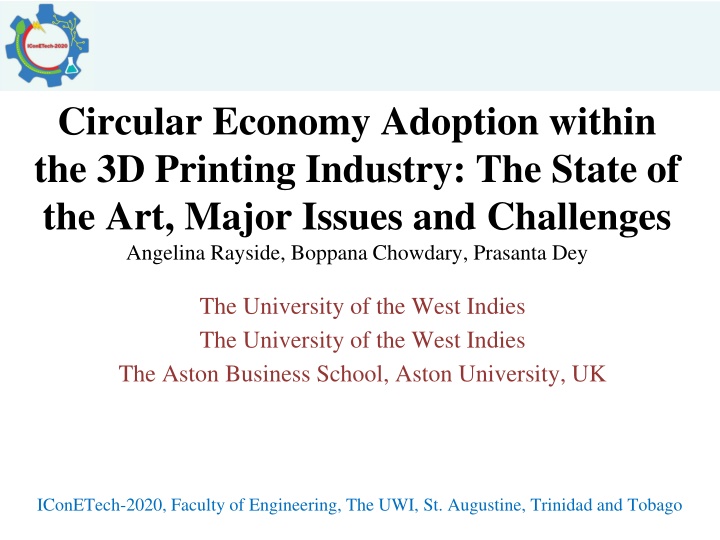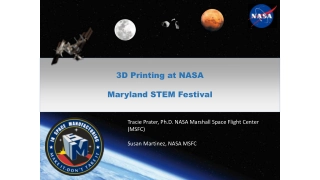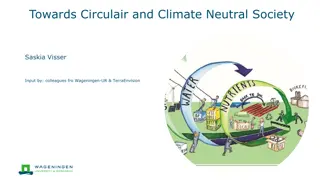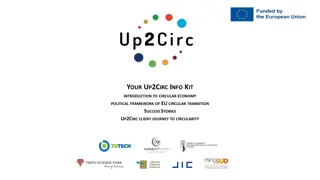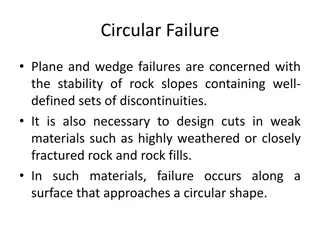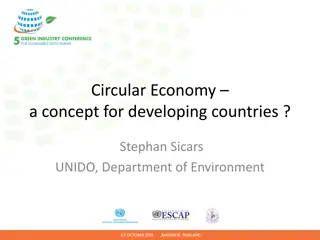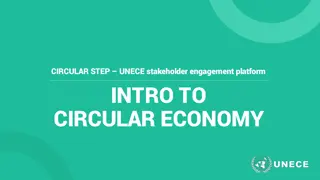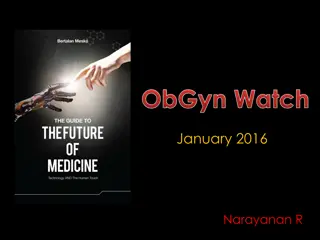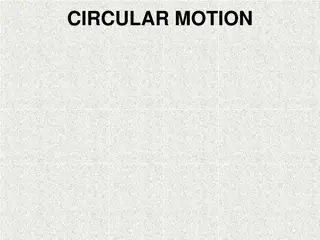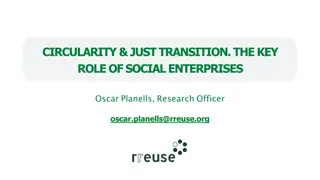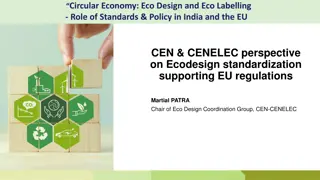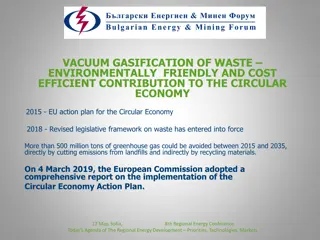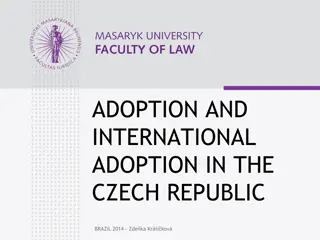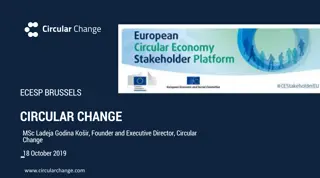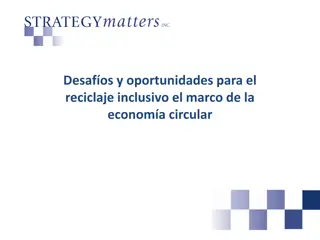Circular Economy Adoption in 3D Printing Industry: State-of-the-Art and Challenges
The integration of 3D printing with Circular Economy is explored to minimize material waste and enhance sustainability. Challenges and advancements in CE adoption are discussed through research findings.
Download Presentation

Please find below an Image/Link to download the presentation.
The content on the website is provided AS IS for your information and personal use only. It may not be sold, licensed, or shared on other websites without obtaining consent from the author.If you encounter any issues during the download, it is possible that the publisher has removed the file from their server.
You are allowed to download the files provided on this website for personal or commercial use, subject to the condition that they are used lawfully. All files are the property of their respective owners.
The content on the website is provided AS IS for your information and personal use only. It may not be sold, licensed, or shared on other websites without obtaining consent from the author.
E N D
Presentation Transcript
Circular Economy Adoption within the 3D Printing Industry: The State of the Art, Major Issues and Challenges Angelina Rayside, Boppana Chowdary, Prasanta Dey The University of the West Indies The University of the West Indies The Aston Business School, Aston University, UK IConETech-2020, Faculty of Engineering, The UWI, St. Augustine, Trinidad and Tobago
INTRODUCTION The Circularity Gap Report 2019 states that 8.9% of the world was operating under circular practices; 9.1% in 2018. Circular Economy revolves around the complete eradication of industrial waste beginning at the product design stage which keeps manufactured products in use within the economy. CE therefore has the potential to revolutionize the manufacturing and production sectors of today, which is currently rapidly inundated by the 3D printing industry. 3D Printing reduces costs and energy usage in transportation, shipping, handling and storage of raw materials. IConETech-2020, Faculty of Engineering, The UWI, St. Augustine, Trinidad and Tobago
INTRODUCTION The integration therefore of 3D printing with Circular Economy further pushes the elimination of material waste and its subsequent issues, and re-integrates spent products back into use. Bio-material usage would allow manufactured products to safely break down into natural elements, and also be re-manufactured without reduction in physical properties or quality. The promises of these however, are not without its challenges. The aim of this paper is to discern the state of the art of this CE adoption, and to determine the issues that have arisen through this integration. IConETech-2020, Faculty of Engineering, The UWI, St. Augustine, Trinidad and Tobago
RESEARCH AIM 1. How does 3D printing facilitate CE adoption and is there any established framework? 2. What are the major challenges that inhibit the progression of CE in the additive manufacturing industry? IConETech-2020, Faculty of Engineering, The UWI, St. Augustine, Trinidad and Tobago
LITERATURE REVIEW Betim et al. (2018), compiled nine research articles and found that recycling, remanufacturing, biomaterials and design were the main research areas. Sauerwein, Bakker & Balkenende (2017) outlined the aspects of additive manufacturing that could result in possibilities for sustainability, such as design for customization, absence of specialized tooling and local production. These aspects were then mapped to the circular design strategies postulated by Bakker et al (2014) using five design project examples. IConETech-2020, Faculty of Engineering, The UWI, St. Augustine, Trinidad and Tobago
LITERATURE REVIEW Diegal et al (2016) identified circular economy as a sustainable design approach and 3D printing as a means to positively contribute to sustainable development. The article identified new sustainability challenges associated with additive manufacturing. Giurco et al (2014) concludes by asserting that additive manufacturing had the potential to reduce material throughput and extend product lifetimes, but without ensuring design for disassembly overall results may be mixed. IConETech-2020, Faculty of Engineering, The UWI, St. Augustine, Trinidad and Tobago
RQ 1 How does 3D printing facilitate CE adoption, and is there any established framework? IConETech-2020, Faculty of Engineering, The UWI, St. Augustine, Trinidad and Tobago
RESEARCH QUESTION 1 Rapid Prototyping Implementation of modularity, disassembly and repair-friendly features into products. Mapping of circular strategies to 3D Printing aspects Contributions of 3D printing to circular aspects The Biosphere Rules IConETech-2020, Faculty of Engineering, The UWI, St. Augustine, Trinidad and Tobago
RESEARCH QUESTION 1 IConETech-2020, Faculty of Engineering, The UWI, St. Augustine, Trinidad and Tobago
RESEARCH QUESTION 1 IConETech-2020, Faculty of Engineering, The UWI, St. Augustine, Trinidad and Tobago
RESEARCH QUESTION 1 IConETech-2020, Faculty of Engineering, The UWI, St. Augustine, Trinidad and Tobago
RQ 2 What are the major challenges that inhibit the progression of CE in the additive manufacturing industry? IConETech-2020, Faculty of Engineering, The UWI, St. Augustine, Trinidad and Tobago
RESEARCH QUESTION 2 IConETech-2020, Faculty of Engineering, The UWI, St. Augustine, Trinidad and Tobago
CONCLUSION 3D printing has the potential to facilitate circular economy by designing out waste, incorporating biomaterials and designing for maintenance and repair and recyclability. The integration of these contain limitations and barriers which are complex and interdependent. It would be beneficial for further research to be pursued in the topic as the world s economies are slowly gearing toward more sustainable practices and as 3D printing technology becomes the new manufacturing norm. IConETech-2020, Faculty of Engineering, The UWI, St. Augustine, Trinidad and Tobago
REFERENCES The Circle Economy Organization. 2019. The Circularity Gap Report 2019. D. V. Betim et al. 2018. Analysis of the application of additive manufacturing in the circular economy: An integrative literature review. Operations Management for Social Good. POMS 2018. Springer Proceedings in Business and Economics. Giurco, D., Littleboy, A., Boyle, T., Fyfe, J., & White, S. (2014). Circular economy: Questions for responsible minerals, additive manufacturing and recycling of metals. Resources, 3(2), 432-453. M. Sauerwein, C.A. Bakker, R.Balkenende. 2017. Additive Manufacturing for circular product design: A literature review from a design perspective. Delft University of Technology and IOS Press. IConETech-2020, Faculty of Engineering, The UWI, St. Augustine, Trinidad and Tobago
REFERENCES O. Diegel et al. 2016. Additive Manufacturing and its Effect on Sustainable Design. Springer Science & Business Media Singapore 2016 Handbook of Sustainability in Additive Manufacturing, Environmental Footprints and Eco-design of Products and Processes, DOI 10.1007/978-981-10-0549-7_5 Unruh, G. (2018). Circular economy, 3D printing, and the biosphere rules. California Management Review, 60(3), 95-111. IConETech-2020, Faculty of Engineering, The UWI, St. Augustine, Trinidad and Tobago
THANK YOU! IConETech-2020, Faculty of Engineering, The UWI, St. Augustine, Trinidad and Tobago
